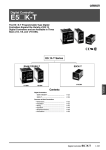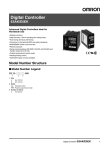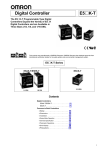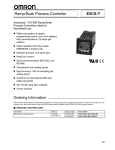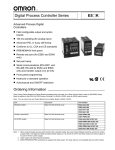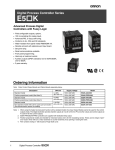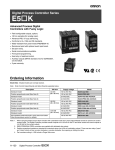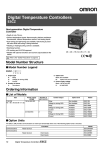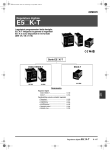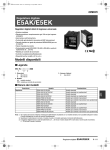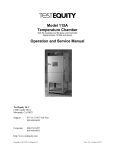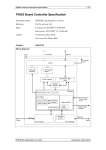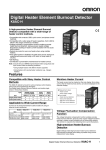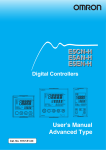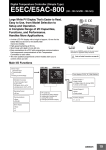Download Ramp/Soak Process Controller E5AK-T/E5EK-T
Transcript
Ramp/Soak Process Controller E5AK-T/E5EK-T Advanced Ramp/Soak Process Controllers Ideal for Worldwide Use E5AK-T offers up to eight patterns of simple programming control (4 patterns for E5EK-T), with 16 steps per pattern Modular structure, one-stock type High-accuracy: 100 ms sampling (for analog input) Conforms to international EMC and safety standards. IP66/NEMA4 (indoor use) front face Serial communications (RS-232C, RS-422 and RS-485) and transfer output (4 to 20 mA) Position-proportional control model is offered Heat/Cool control 24 V AC/DC types also available Ordering Information When ordering, order control output boards and option boards separately. Example: for a relay control output, order the E53-R output board in addition to the standard Process Controller (E5AK-T/E5EK-T). Also specify the current transformer. PROCESS CONTROLLERS Item Description Part number Base unit Standard model with terminal cover E5AK-TAA2-500 AC100-240 E5AK-TAA2-500 AC/DC24 Position-proportional model with terminal cover E5AK-TPRR2-500 AC100-240 E5AK-TPRR2-500 AC/DC24 Standard model with terminal cover E5EK-TAA2-500 AC100-240 E5EK-TAA2-500 AC/DC24 Position-proportional model with terminal cover E5EK-TPRR2-500 AC100-240 E5EK-TPRR2-500 AC/DC24 Note: 1. When using the heater burnout alarm function with a standard model, the linear output board cannot be used for the control outputs (heat). 2. The Process Controller provides transfer outputs at 4 to 20 mA for the PV and other values and control outputs at 4 to 20 mA for the current outputs. E5AK-T/E5EK-T E5AK-T/E5EK-T OUTPUT BOARDS Item Description Part number Output board Relay E53-R SSR E53-S Pulse (NPN) 12 VDC E53-Q Pulse (NPN) 24 VDC E53-Q3 Pulse (PNP) 24 VDC E53-Q4 Linear (4 to 20 mA) E53-C3 Linear (0 to 20 mA) E53-C3D Linear (0 to 10 V) E53-V34 Linear (0 to 5 V) E53-V35 Note: The Controller uses a dedicated, high-resolution output board. The E53-C current output board for the E5 X cannot be used with the E5AK-T/E5EK-T Controller. OPTION BOARD Item Description Part number Option board Event input E53-AKB Communication (RS-232C) E53-AK01 Communication (RS-422) E53-AK02 Communication (RS-485) E53-AK03 Transfer output E53-AKF Note: 1. The option board can be used either by the E5AK or E5EK. 2. The E5AK-T allows a maximum of three option boards to be mounted. Refer to the Operations Section for mounting combinations. The E5EK-T allows only one option board to be mounted. ACCESSORIES (ORDER SEPARATELY) Current Transformer Item Hole diameter Part number Current transformer (See ( Note.)) 5.8 mm E54-CT1 12.0 mm E54-CT3 Note: No CT is required unless the heater burnout alarm function is used. Terminal Cover Item Connectable models Part number Terminal cover E5AK E53-COV0809 E5EK E53-COV08 Unit Label Item Part number Unit label Y92S-L1 E5AK-T/E5EK-T E5AK-T/E5EK-T TEMPERATURE RANGES Platinum Resistance Thermometer Input (See Note.) Range g JPt100 Pt100 °C --199.9° to 650.0° --199.9° to 650.0° °F --199.9° to 999.9° --199.9° to 999.9° 0 1 Setting (°C/°F) (main setting and alarm) Note: Switch selectable. Thermocouple Input (see note) Range K1 K2 J1 J2 T E L1 L2 U N R S B W PL °C --200 to 1,300 0.0 to 500.0 --100 to 850 0.0 to 400.0 --199.9 to 400.0 0 to 600 --100 to 850 0.0 to 400.0 --199.9 to 400.0 --200 to 1,300 0 to 1,700 0 to 1,700 100 to 1,800 0 to 2,300 0 to 1,300 °F --300 to 2,300 0.0 to 900.0 --100 to 1,500 0.0 to 750.0 --199.9 to 700.0 0 to 1,100 --100 to 1,500 0.0 to 750.0 --199.9 to 700.0 --300 to 2,300 0 to 3,000 0 to 3,000 300 to 3,200 0 to 4,100 0 to 2,300 2 3 4 5 6 7 8 9 10 11 12 13 14 15 16 Resolution (°C/°F) (main setting and alarm) Note: Switch selectable: Setting number is factory-set to 2 (K1). Thermocouple W is W/Re5-26 (tungsten rhenium 5, tungsten rhenium 26). Current/Voltage Input (See ( Note.)) Current input 4 to 20 mA Voltage input 0 to 20 mA 1 to 5 V Range One of following ranges depending on results of scaling --1999 to 9999 --199.9 to 999.9 --19.99 to 99.99 --1.999 to 9.999 Setting 17 Note: Switch selectable. 18 19 0 to 5 V 0 to 10 V 20 21 E5AK-T/E5EK-T E5AK-T/E5EK-T Specifications RATINGS Model E5EK/AK-T (Standard) E5EK/AK-T (24 V Type) Supply voltage 100 to 240 VAC, 50/60 Hz 24 VAC/VDC, 50/60 Hz E5AK-T 16 VA 12 VA,, 8 W E5EK-T 15 VA Power consumption Operating voltage range Input Control output 85% to 110% of rated supply voltage Thermocouple K, J, T, E, L, U, N, R, S, B, W, PL Platinum resistance thermometer JPt100, Pt100 Current input 4 to 20 mA, 0 to 20 mA (Input impedance: 150 Ω) Voltage input 1 to 5 V, 0 to 5 V, 0 to 10 V (Input impedance: 1 MΩ) Standard model According to Output Unit (see Output Board Ratings and Characteristics) Position-proportional model (See Note.) 2 Relay outputs: SPST-NO, 1 A at 250 VAC (including inrush current) Auxiliary output SPST-NO, 3 A at 250 VAC (resistive load) Control method ON/OFF or advanced PID control (with auto-tuning) Setting method Digital setting using front panel keys or communications features Indication method 7-segment digital display and LEDs 100 Ω to 2.5 kΩ Potentiometer Event input Contact input ON: 1 kΩ max., OFF: 100 kΩ min. No-contact input ON: residual voltage: 1.5 V max., OFF: leakage current: 0.1 mA max. 4 to 20 mA, permissible load impedance: 600 Ω max., resolution: approx. 2,600 steps Transmission output Current transformer input Additional functions Connect only Omron Current Transformer (E54-CT1 or E54-CT3) Standard Approved standards Note: All control outputs are insulated from the input circuit. Manual output, heating/cooling control, SP limiter, loop burnout alarm, MV limiter, MV change rate limiter, input digital filter, input shift, run/reset, protect functions, scaling function UL 1092, CSA22.2 No. 14, CSA22.2 No. 1010-1 Conforms to EN50081 EN50081-2, 2 EN50082 EN50082-2, 2 EN61010 EN61010-1 1 (IEC1010 (IEC1010-1) 1) Conforms to VDE0106/ art 100 (Finger Protection), when the se separatelyaratelyVDE0106/part ordered terminal cover is mounted. E5AK-T/E5EK-T E5AK-T/E5EK-T CHARACTERISTICS Indication accuracyy (S Note (See N t 1.) 1) Thermocouple (±0.3% of indication value or ±1°C, whichever greater) ±1 digit max. Platinum resistance thermometer (±0.2% of indication value or ±0.8°C, whichever greater) ±1 digit max. Analog input ±0.2% (of indication value) ±1 digit max. Hysteresis 0.01% to 99.99% FS (in units of 0.01% FS) Proportional band (P) 0.1% to 999.9% FS (in units of 0.1% FS) Integral (reset) time (I) 0 to 3,999 s (in units of 1 s) Derivative (rate) time (D) 0 to 3,999 s (in units of 1 s) Control period 1 to 99 s (in units of 1 s) Manual reset value 0.0% to 100.0% (in units of 0.1%) Alarm setting range --1,999 to 9,999 or --199.9 or 999.9 (decimal point position dependent on input type or result of scaling) Set time 0 to 99 hrs 59 min or 0 to 99 min 59 s Program capacity 8 patterns (E5AK-T) or 4 patterns (E5EK-T), 16 steps Programming method Time or ramp setting method ±0.2% (±500 ms) of the set value Time accuracy Sampling g period (S Note (See N t 2.) 2) Temperature input 250 ms Analog input 100 ms Insulation resistance 20 MΩ min. (at 500 VDC) Dielectric strength 2,000 VAC, 50/60 Hz for 1 min between terminals of different polarities Vibration resistance Malfunction: 10 to 55 Hz, 10 m/s2 (approx. 1G) for 10 min each in X, Y, and Z directions Destruction: 10 to 55 Hz, 20 m/s2 (approx. 2G) for 2 hrs each in X, Y, and Z directions Malfunction: 200 m/s2 min. (approx. 20G), 3 times each in 6 directions (100 m/s2 (approx. 10G) applied to the relay) Shock resistance Destruction: 300 m/s2 min. (approx. 30G), 3 times each in 6 directions Ambient temperature Operating --10°C to 55°C (14°F to 131°F) with no icing and 3-year warranty period: --10°C to 50°C (14°F 122°F) Storage --25°C to 65°C (--13°F to 149°F) with no icing Ambient humidity Operating 35% to 85% Enclosure ratings g Front panel NEMA4 for indoor use (equivalent to IP66) Rear case IEC standard IP20 Terminals IEC standard IP00 Memory protection Weight g Non-volatile memory (number of writings: 100,000 operations) E5AK-T approx. 450 g E5EK-T approx. 320 g Mounting bracket approx. 65 g (This table continues on the next page.) Note: 1. The indication accuracy of the K1, T, and N thermocouples at a temperature of -100°C max. is ±2°C ±1 digit maximum. The indication accuracy of the U and L thermocouples at any temperature is ±2°C ±1 digit maximum. The indication accuracy of the B thermocouple at a temperature of 400°C max. is unrestricted. The indication accuracy of the R and S thermocouples at a temperature of 200°C max. is ±3°C ±1 digit maximum. The indication accuracy of the W thermocouple at any temperature is (±0.3% of the indicated value or ±3°C, whichever is greater) ±1 digit maximum. The indication accuracy of the PL thermocouple at any temperature is (±0.3% of the indicated value or ±2°C, whichever is greater) ±1 digit maximum. 2. The sampling period of the standard model with CT and remote SP inputs is 250 ms. E5AK-T/E5EK-T E5AK-T/E5EK-T Characteristics Table -- continued from previous page EMC Emission Enclosure: Emission AC Mains: Immunity ESD: Approved standards UL1092, CSA22.2 No. 14, CSA22.2 No. 1010-1 Conforms to EN50081-2, EN50082-2, EN61010-1 (IEC1010-1) Conforms to VDE0106/part 100 (Finger Protection), when the separately-ordered terminal cover is mounted. EN55011 Group 1 class A EN55011 Group 1 class A EN61000-4-2: 4 kV contact discharge (level 2) 8 kV air discharge (level 3) Immunity RF-interference: ENV50140: 10 V/m (amplitude modulated, 80 MHz to 1 GHz) (level 3) 10 V/m (pulse modulated, 900 MHz) Immunity Conducted Disturbance: ENV50141:10 V (0.15 to 80 MHz) (level 3) Immunity Burst: EN61000-4-4: 2 kV power-line (level 3) 2 kV I/O signal-line (level 4) OPTION BOARD RATINGS AND CHARACTERISTICS Model Description Specifications E53-AKB Event input Contact input: ON: 1 kΩ max., OFF: 100 kΩ min. No-contact input: ON: residual voltage 1.5 V max., OFF: leakage current 0.1 mA max. E53-AK01 Communications E53-AK02 RS-422 E53-AK03 E53-AKF RS-232C Transmission method: Half-duplex S Synchronization h i ti method: th d Start-stop St t t synchronization h i ti (asynchronous ( h method) th d) Baud rate: 1.2/2.4/4.8/9.6/19.2 1 2/2 4/4 8/9 6/19 2 kbps RS-485 4 to 20 mA: Permissible load impedance: 600 Ω max.; Resolution: approx. 2,600 steps Transfer output Note: Event input is used for switching the target value, run or stop command, or automatic and manual mode with an external signal input. CURRENT TRANSFORMER RATINGS Maximum continuous heater current 50 amps Dielectric strength 1,000 VAC (for 1 min) Vibration resistance 50 Hz, 98 m/s2 (10G) Weight g Accessories (E54-CT3 ( only) y) E54-CT1 approx. 11.5 g E54-CT3 approx. 50 g Armature 2 Plug 2 HEATER BURNOUT ALARM Max. heater current Single-phase 50 A VAC (See Note 1.) Heater current value display accuracy ±5% FS±1 digit max. Heater burnout alarm setting range 0.1 to 49.9 A (in units of 0.1 A) (See Note 2.) Min. detection ON time 190 ms (See Note 3.) Note: 1. Use the K2CU-F A- GS (with gate input terminals) for the detection of three-phase heater burnout. 2. The heater burnout alarm is always OFF if the alarm is set to 0.0 A and always ON if the alarm is set to 50.0 A. 3. No heater burnout detection or heater current value measurement is possible if the control output (heat) is ON for less than 190 ms. E5AK-T/E5EK-T E5AK-T/E5EK-T Nomenclature E5AK-T Display 1 Pattern Number Indicates the pattern number. Displays the process value or parameter code. Program Status Indicators The top indicator indicates the rising step, the middle indicator indicates the constant step, and the bottom indicator indicates the falling step. Display 2 Displays the present SP, manipulated variable, or parameter settings. Bar Graph Indicates the rate of pattern elapsing time at the rate of 20% (5 levels) per one segment. Operation Indicators • OUT1 Lit when the pulse output function assigned to control output 1 turns ON. • OUT2 Lit when the pulse output function assigned to control output 2 turns ON. • SUB1 Lit when the output function assigned to auxiliary output 1 turns ON. • SUB2 Lit when the output function assigned to auxiliary output 2 turns ON. • MANU Lit when the manual operation mode. • RST Lit when the operation is reset. • RMT Lit during remote operation. • AT Flashes during auto-tuning. • HOLD Lit when the program is on hold. • WAIT Lit when the program is waiting. Up Key/Down Key Press to increase or decrease the value on the No.2 display. Display Key Press to shift the display to the next parameter. RUN/RST Key Switches between RUN and RESET mode. E5EK-T Display 1 Display 2 Operation indicators Up Key/Down Key Display Key RUN/RST Key E5AK-T/E5EK-T E5AK-T/E5EK-T Operation Note: Before changing any switch settings, always turn OFF the power supply to the Process Controller SETTINGS 1. On a standard model, set up the output boards for control outputs 1 and 2 before mounting the Controller. 2. On a position-proportional model, the relay output board is already set, so this setup operation is unnecessary. (Do not replace with other output boards.) 3. When setting up the output boards, remove the internal mechanism from the housing and insert the output boards into the sockets for control outputs 1 and 2. Setting Up the Option Board E5AK-T 1. Remove the power board and option boards in the order shown in the following diagram. Setting Up the Output Board Removing the Output Board To replace the output board, use a flat-blade screwdriver to push up the output board. 2. Insert the option boards into the sockets for options 1 to 3. The following diagram shows the relationship between the option boards and mounting positions. 3. Mount the option boards and the power board in the order shown. E5AK-T/E5EK-T E5AK-T/E5EK-T E5EK-T Removing the Internal Mechanism 1. Remove the power board and option boards in the order shown in the following diagram. To remove the internal mechanism from the housing, use a Phillips screwdriver matching the screw on the lower part of the front panel. 1. Turn the screw counterclockwise while pressing the hook on the upper part of the front panel. Hook 2. Carefully pull out the internal mechanism while holding the left and right sides of the front panel. 2. Insert the option board into the socket for option 1. The following diagram shows the relationship between the option board and mounting position. 3. Mount the option board and the power board in the order shown. Mounting 1. Insert the E5AK-T Controller into the panel’s mounting hole at the position shown in the figure below. 2. Fit the mounting bracket (accessory) into the fixing slots on the top and bottom of the rear case. 3. Tighten the mounting bracket screws on the upper and lower parts of the E5AK-T in small increments alternately and equally until the ratchet starts to slide. E5AK-T/E5EK-T E5AK-T/E5EK-T E53-COV0809, E53-COV08 Terminal Cover (Order Separately) Fasten the terminals covers as follows by using the snap pins. Note: Snap pins are provided with the terminal covers. E5AK-T E5EK-T Dimensions Unit: mm (inch) E5AK-T 96 x 96 (3.78 x 3.78) 13.5 (0.53) Panel Cutouts 100 (3.94) 91 x 91 112 (4.41) 110 (4.33) min. 120 (4.72) min. Note: 1. Recommended panel thickness is 1 to 8 mm. 2. Maintain the specified vertical and horizontal mounting space between each Unit. Units must not be closely mounted (vertically or horizontally). E5AK-T/E5EK-T E5AK-T/E5EK-T E5EK-T Panel Cutouts 48 (1.89) 60 (2.36) min. 91 96 (3.78) 112 (4.41) 100 (3.94) 120 (4.72) min. Note: 1. Recommended panel thickness is 1 to 8 mm. 2. Maintain the specified vertical and horizontal mounting space between each Unit. Units must not be closely mounted vertically or horizontally. ACCESSORIES (ORDER SEPARATELY) Terminal Cover E53-COV0809 E53-COV08 22.05 (0.87) 43.2 (1.70) 3 (0.12) 89 (3.50) 89 (3.50) 89 (3.50) 43.2 (1.70) 3 (0.12) 3 (0.12) 3 (0.12) 1.5 (0.06) 1.5 (0.06) Current Transformer E54-CT1 21 (0.83) 15 2.8 (0.11)dia. 5.8 (0.23) dia. 7.5 (0.30) 25 (0.98) 10.5 (0.41) 40 (1.57) 10 (0.39) 30 (1.18) E5AK-T/E5EK-T E5AK-T/E5EK-T Unit: mm (inch) E54-CT3 2.36 (0.09)dia. 30 (1.18) 12 dia. 9 (0.35) 40 (1.57) x 40 (1.57) Two, M3 (depth: 4) 15 (0.59) 30 (1.18) Installation INSTALLATION SETTING UP THE OUTPUT BOARD Main Parts 1. Two rectangular holes are provided on the power board (right side of Controller). Fit the two protrusions of the output board into these two holes. 2. With the output board fitted into the power board, fit the output board into the connector on the control board (left side of Controller). Terminals Output Board Housing 1 2 Input type connector Option Board Front panel Removing Internal Mechanism While pressing the hooks on the left and right sides of the front panel, carefully pull the internal mechanism from the housing. (Refer to the drawing below.) SETTING UP THE OPTION BOARD 1. Place the Controller bottom up, and fit the option board horizontally into the connector on the power board (right side of Controller). 2. With the power board connected, fit the board vertically into the connector on the control board (left side of controller). 1 2 E5AK-T/E5EK-T E5AK-T/E5EK-T MOUNTING THE CONTROLLER 1. Insert the Controller into the panel’s mounting hole at the position shown in the figure below. 2. Push the adapter along the Controller body from the terminals up to the panel, and fasten temporarily. 3. Tighten the two fixing screws on the adapter. When tightening screws, tighten the two screws alternately keeping the torque to approximately 0.29 to 0.39 N m, or 3 to 4 kgf cm. Adapter Panel Watertight packing Input Jumper Setting Note: The jumper is factory-set to TC PT (temperature input). Set the jumper to temperature, voltage, or current input according to the sensor connected to the input terminal. I: Current input V: Voltage input Note: Do not touch the pins of the jumper connector when setting the input type. TC PT: Temperature input After setting the jumper, put on the housing, pressing the housing until the hooks of the front panel snap on. E5AK-T/E5EK-T E5AK-T/E5EK-T WIRING TERMINALS Terminal Arrangement E5EK-T E5AK-T AC100--240V 50/60 Hz (AC/DC24V) AC100--240V 50/60 Hz (AC/DC24V) SOURCE SOURCE TRSF: EV1/2: PTMR: TRSF: Transfer output EV1 to 4: Event input PTMR: Potentiometer Transfer output Event input Potentiometer WIRING PRECAUTIONS • • • Use ducts to separate input leads and power lines in order to protect the Controller and its lines from external noise. Solderless terminals are recommended when wiring the Controller. Tighten the terminal screws using a torque no greater than 0.78 N m, or 8 kgf cm max. Be careful not to tighten the terminal screws too tightly. Power Blocks for E5AK-T/EK-T The E5AK/E5EK has independent power supplies for each of the terminal blocks shown below. E5AK-T A B 10 9 8 7 6 5 4 3 2 1 B E F E5EK-T C A C 30 31 32 29 28 27 26 25 24 23 22 21 33 20 19 18 17 16 15 14 13 12 11 10 21 22 9 8 7 6 5 4 3 2 1 23 B E D B/C F C 20 19 18 17 16 15 14 13 12 11 D E5AK-T/E5EK-T E5AK-T/E5EK-T E5AK-T WIRING In the following wiring diagrams, the left side of the terminal numbers indicate the inside of the Controller. Power Supply Input 100 to 240 VAC or AC/DC 24 V to terminal numbers 9 and 10 according to the specifications. Sensor Input Connect the sensor input to terminal numbers 11 to 14 and 33 as follows according to the input type. Control Output Terminal numbers 7 and 8 are for control output 1 (OUT1), and terminal numbers 5 and 6 are for control output 2 (OUT2). The following diagrams show the available output boards and their internal equalizing circuits. With E53-V output boards, approx. 2 V is output for one second after the power is interrupted. E5AK-T/E5EK-T E5AK-T/E5EK-T Specifications for Each Output Board Model Output type Specifications E53-R Relay 5 A at 250 VAC E53-S SSR 1 A at 75 to 250 VAC E53-Q E53-Q3 E53-Q4 Voltage (NPN) Voltage (NPN) Voltage (PNP) NPN: 40 mA at 12 VDC (with short-circuit protection) NPN: 20 mA at 24 VDC (with short-circuit protection) PNP: 20 mA at 24 VDC (with short-circuit protection) E53-C3 E53-C3D 4 to 20 mA 0 to 20 mA 4 to 20 mA; permissible load impedance: 600 Ω max.; resolution: approx. 2600 0 to 20 mA; permissible load impedance: 600 Ω max.; resolution: approx. 2600 E53-V34 E53-V35 0 to 10 V 0 to 5 V 0 to 10 VDC; permissible load impedance: 1 kΩ min.; resolution: approx. 2600 0 to 5 VDC; permissible load impedance: 1 kΩ min.; resolution: approx. 2600 With E5AK-PRR2 Controllers, the relay output (1 A at 250 VAC) is fixed. When replacing the output board, use the E53-R. The following diagrams show the relationship between terminals and open/close relay settings. 8 6 7 5 Open Close Auxiliary Output Terminal numbers 3 and 4 are for auxiliary output 1 (SUB1) and terminal numbers 1 and 2 are for auxiliary output 2 (SUB2). The following diagrams show the internal equalizing circuits for the auxiliary outputs: 10 9 8 7 6 5 4 3 2 1 30 31 32 29 28 27 26 25 24 23 22 21 33 20 19 18 17 16 15 14 13 12 11 4 2 3 1 Auxiliary output 1 Auxiliary output 2 Output specifications are as follows: SPST-NO, 3 A at 250 VAC CT Input/Potentiometer When using the HBA function on the E5AK-TAA2 Controller, connect CT input (CT) to terminal numbers 15 to 17. When monitoring the valve opening on the E5AK-TPRR2 Controller, connect the potentiometer (PTMR) to terminal numbers 15 to 17. Connect each of these inputs as follows: 10 9 8 7 6 5 4 3 2 1 30 31 32 29 28 27 26 25 24 23 22 21 33 20 19 18 17 16 15 14 13 12 11 17 16 17 CT 16 O W C 15 15 CT input Potentiometer For details on CT inputs, refer to Appendix, About Current Transformer in the E5AK-T/E5EK-T User’s Manual (H83/H85). For details on the potentiometer, refer to the Instruction Manual for the valve connected to the Controller. The variable resistance range is 100 Ω to 2.5 kΩ. E5AK-T/E5EK-T E5AK-T/E5EK-T Remote SP Input Connect the input (RSP) to be used as the remote SP to terminal numbers 21 and 22. Only 4 to 20 mA inputs can be connected. Connect the input as follows: 10 9 8 7 6 5 4 3 2 1 30 31 32 29 28 27 26 25 24 23 22 21 33 20 19 18 17 16 15 14 13 12 11 22 + 4 to 20 mA 21 -- Event Input Connect event inputs 1 and 2 (EV1/2) to terminal numbers 18 to 20, and events 3 and 4 (EV3/4) to terminal numbers 24 to 26. However, note that terminal numbers 18 to 20 cannot be used on Controllers with a communications function. Connect the event inputs as follows: 10 9 8 7 6 5 4 3 2 1 30 31 32 29 28 27 26 25 24 23 22 21 33 20 19 18 17 16 15 14 13 12 11 EV1 20 EV2 19 COM 18 + + -- Event input 1 and 2 EV3 26 EV4 25 COM 24 + + -- Event input 3 and 4 Terminals 18 and 24 (COM) are connected internally. Use event inputs under the following conditions: Contact input ON: 1 kΩ max. OFF: 100 kΩ min. No-contact input ON: Residual voltage 1.5 V max., OFF: Leakage current 0.1 mA max. Polarities during no-contact input are as follows: EV1 20 EV2 19 COM 18 + EV3 26 EV4 25 COM 24 + -- Event input 1 and 2 + + -- Event input 3 and 4 E5AK-T/E5EK-T E5AK-T/E5EK-T Transfer Output Connect transfer output (TRSF) to terminal numbers 29 and 30. The internal equalizing circuit for transfer output is as follows: + 30 4 to 20mA L 29 -- Transfer output specifications are as follows: 4 to 20 mA Permissible load impedance: 600 Ω max. Resolution: approx. 2600 Communications Terminal numbers 18 to 20, 31 and 32 can be used only on Controllers with communications boards (E53-AK01/02/03). For details on wiring, refer to Chapter 6, Using the Communications Function in the E5AK-T/E5EK-T User Manuals (H83 and H85). E5EK-T WIRING In the following wiring diagrams, the left side of the terminal numbers indicate the inside of the Controller. Power Supply Input 100 to 240 VAC or AC/DC 24 V to terminal numbers 9 and 10 according to the specifications. Sensor Input Connect the sensor input to terminal numbers 11 to 14 and 33 as follows according to the input type. E5AK-T/E5EK-T E5AK-T/E5EK-T Control Output Terminal numbers 7 and 8 are for control output 1 (OUT1), and terminal numbers 5 and 6 are for control output 2 (OUT2). The following diagrams show the available output boards and their internal equalizing circuits. With E53-V output boards, approx. 2 V is output for one second after the power is interrupted. Specifications for Each Output Board Model Output type Specifications E53-R Relay 5 A at 250 VAC E53-S SSR 1 A at 75 to 250 VAC E53-Q E53-Q3 E53-Q4 Voltage (NPN) Voltage (NPN) Voltage (PNP) NPN: 40 mA at 12 VDC (with short-circuit protection) NPN: 20 mA at 24 VDC (with short-circuit protection) PNP: 20 mA at 24 VDC (with short-circuit protection) E53-C3 E53-C3D 4 to 20 mA 0 to 20 mA 4 to 20 mA, permissible load impedance: 600 Ω max., resolution: approx. 2600 0 to 20 mA, permissible load impedance: 600 Ω max., resolution: approx. 2600 E53-V34 E53-V35 0 to 10 V 0 to 5 V 0 to 10 VDC, permissible load impedance:1 kΩ min., resolution: approx. 2600 0 to 5 VDC, permissible load impedance: 1 kΩ min., resolution: approx. 2600 With E5EK-TPRR2 Controllers, the relay output (1 A at 250 VAC) is fixed. When replacing the output board, use the E53-R. The following diagrams show the relationship between terminals and open/close relay settings. 8 6 7 5 Open Close Auxiliary Output Terminal numbers 3 and 4 are for auxiliary output 1 (SUB1) and terminal numbers 1 and 2 are for auxiliary output 2 (SUB2). The following diagrams show the internal equalizing circuits for the auxiliary outputs: 10 21 22 9 8 7 6 5 4 3 2 1 23 20 19 18 17 16 15 14 13 12 11 4 3 Auxiliary output 1 2 1 Auxiliary output 2 Output specifications are as follows: SPST-NO, 3A at 250 VAC E5AK-T/E5EK-T E5AK-T/E5EK-T CT Input/Potentiometer When using the HBA function on the E5EK-TAA2 Controller, connect CT input (CT) to terminal numbers 15 to 17. When monitoring the valve opening on the E5EK-TPRR2 Controller, connect the potentiometer (PTMR) to terminal numbers 15 to 17. Connect each of these inputs as follows: 10 21 22 9 8 7 6 5 4 3 2 1 23 20 19 18 17 16 15 14 13 12 11 17 17 16 16 15 15 CT input O W C Potentiometer For details on CT inputs, refer to Appendix, About Current Transformer in the E5AK-T/E5EK-T User’s Manual (H83/H85). For details on the potentiometer, refer to the Instruction Manual for the valve connected to the Controller. The variable resistance range is 100 Ω to 2.5 kΩ. Remote SP Input Connect the input (RSP) to be used as the remote SP to terminal numbers 15 and 16. However, note that the remote SP cannot be used on the E5EK-TPRR2 Controller. Only 4 to 20 mA inputs can be connected. Connect the input as follows: 10 21 22 9 8 7 6 5 4 3 2 1 23 20 19 18 17 16 15 14 13 12 11 16 + 4 to 20 mA 15 -- Event Input Connect event inputs 1 and 2 (EV1/2) to terminal numbers 18 to 20. However, note that terminal numbers 18 to 20 cannot be used on Controllers with a communications function. Connect the event inputs as follows: 10 21 22 9 8 7 6 5 4 3 2 1 23 20 19 18 17 16 15 14 13 12 11 EV1 20 EV2 19 COM 18 + + -- Event input 1 and 2 Use event inputs under the following conditions: Contact input ON: 1 kΩ max., OFF: 100 kΩ min. No-contact input ON: Residual voltage 1.5 V max., OFF: Leakage current 0.1 mA max. E5AK-T/E5EK-T E5AK-T/E5EK-T Polarities during no-contact input are as follows: EV1 EV2 COM + 20 19 + 18 -- Event input 1 and 2 Transfer Output Connect transfer output (TRSF) to terminal numbers 21 and 22. The internal equalizing circuit for transfer output is as follows: 21 + 4 to 20mA L 22 -- Transfer output specifications are as follows:4 to 20 mA, Permissible load impedance: 600 Ω max., Resolution: Approx. 2600 Communications Terminal numbers 18 to 22 can be used only on controllers with communications boards (E53-AK01/02/03). For details on wiring, refer to Chapter 6, Using the Communications Function in the E5AK-T/E5EK-T User Manuals (H088-E3-1 and H089-E3-1). E5AK-T/E5EK-T E5AK-T/E5EK-T AFTER TURNING POWER ON INPUT TYPE Determine the I/O specifications of the Process Controller in setup mode. Set the code according to the following table. Default is “2: K1 thermocouple.” Platinum Resistance Thermometer Power ON Process value 1 s min. 1 s min. Set value 0 Input In ut type ty e JPt100 --199.9 to 650.0 (°C) /--199.9 to 999.9 (°F) 1 Pt100 --199.9 to 650.0 (°C) /--199.9 to 999.9 (°F) 2 K1 --200 to 1,300 (°C) /--300 to 2,300 (°F) 3 K2 0.0 to 500.0 (°C) /0.0 to 900.0 (°F) 4 J1 --100 to 850 (°C) /--100 to 1,500 (°F) 5 J2 0.0 to 400.0 (°C) /0.0 to 750.0 (°F) 6 T --199.9 to 400.0 (°C) /--199.9 to 700.0 (°F) 7 E 0 to 600 (°C) /0 to 1,100 (°F) 8 L1 --100 to 850 (°C) /--100 to 1,500 (°F) 9 L2 0.0 to 400.0 (°C) /0.0 to 750.0 (°F) 10 U --199.9 to 400.0 (°C) /--199.9 to 700.0 (°F) 11 N --200 to 1,300 (°C) /--300 to 2,300 (°F) 12 R 0 to 1,700 (°C) /0 to 3,000 (°F) 13 S 0 to 1,700 (°C) /0 to 3,000 (°F) 14 B 100 to 1,800 (°C) /300 to 3,200 (°F) 15 W 0 to 2,300 (°C) /0 to 4,100 (°F) 16 PL 0 to 1,300 (°C) /0 to 2,300 (°F) 17 4 to 20 mA 18 0 to 20 mA 19 1 to 5 V 20 0 to 5 V 21 0 to 10 V Input type Temperature input Current/Voltage input Scaling upper limit °C/°F selection Scaling lower limit Decimal point Parameter initialize From next page To next page Platinum resistance thermometer h Thermocouple Current input Voltage input E5AK-T/E5EK-T E5AK-T/E5EK-T PARAMETER INITIALIZE STANDARD MODELS Parameter initialization sets all parameters to default values except for the input type, scaling upper limit, scaling lower limit, decimal point, and °C/°F selection parameters. To previous page From previous page Control output 1 assignment (Not displayed by the E5 K-TPRR2) Control output 2 assignment (Not displayed by the E5 K-TPRR2) Output assignment Auxiliary output 1 assignment Auxiliary output 2 assignment (Not displayed by the E5CK) Assignment destination Control output Auxiliary output O Output function f i 1 2 1 2 Control output (heat) Yes Yes --- --- Control output (cool) Yes Yes --- --- Alarm 1 Yes Yes Yes Yes Alarm 2 Yes Yes Yes Yes Alarm 3 Yes Yes Yes Yes HBA Yes Yes Yes Yes LBA Yes Yes Yes Yes Error 1: Input error --- --- Yes Yes Error 2: A/D converter error --- --- Yes Yes With control output (cool), the conditions for switching from standard control to heating and cooling control are reached when the output function is assigned at the cooling side during heating and cooling control. Alarm 1 type In other words, heating and cooling control is carried out when control output (cool) is assigned, and standard control is carried out when output is not assigned. Alarm 1 open in alarm Alarm 1, 2, or 3 is not set. POSITION-PROPORTIONAL MODELS Alarm 2 type Alarm type Alarm 2 open in alarm Alarm 3 type Alarm 3 open in alarm Assignment destination Control output Auxiliary output O Output function f i 1 2 1 2 Alarm 1 --- --- Yes Yes Alarm 2 --- --- Yes Yes Alarm 3 --- --- Yes Yes Error 1: Input error --- --- Yes Yes Error 2: A/D converter error --- --- Yes Yes Error 3: RSP input error --- --- Yes Yes LBA Direct/Reverse operation OUTPUT ASSIGNMENTS Signals available as allocated outputs are the control output (heat), control output (cool), alarm 1, alarm 2, alarm 3, LBA, and HBA. The auxiliary outputs of the Process Controller cannot be used as control outputs. Control output (heat), control output (cool), alarm 1, alarm 2, alarm 3, LBA, error 1 (input error), and error 2 (A/D converter error) output functions are available. These functions are assigned to control outputs 1 and 2 and auxiliary outputs 1 and 2. The assignment destination of each output function is restricted. Refer to the tables provided under the headings, Standard Models and Position-Proportionate Models. The LBA (loop break alarm) function is available when it is assigned as an output. The LBA function is not available when a memory or A/D converter error results. LBA is a function for determining that an error has occurred somewhere on the control loop and outputting an alarm when the process value does not change with the manipulated variable at a maximum or minimum state. Accordingly, the LBA function can be used as a means for detecting a malfunctioning control loop. E5AK-T/E5EK-T E5AK-T/E5EK-T ALARM MODE SELECTORS Alarm outputs are available if they are allocated as outputs. Factory setting is “2: Upper-limit alarm (deviation).” Switch setting 1 Alarm operation Alarm output When X is positive Upper- and lower-limit alarm (deviation) X ON OFF 2 Upper-limit alarm (deviation) When X is negative X Always ON SP X ON ON OFF OFF SP 3 Lower-limit alarm (deviation) X ON X SP X ON OFF OFF SP 4 Upper- and lower-limit range alarm (deviation) X ON OFF 5 6 Upper- and lower-limit alarm with standby sequence (deviation) Upper-limit alarm with standby sequence (deviation) SP X Always OFF X Always OFF SP X ON OFF SP X ON ON OFF OFF SP 7 Lower-limit alarm with standby sequence (deviation) X ON Absolute-value upper-limit alarm OFF X ON ON OFF Absolute-value lower-limit alarm ON OFF Absolute-value upper-limit alarm with standby sequence X ON ON OFF Absolute-value lower-limit alarm with standby sequence X 0 X ON 0 OFF 0 11 X OFF 0 10 SP X 0 X ON X OFF 0 9 SP ON OFF SP 8 X ON OFF OFF 0 X 0 Deviation Alarm Absolute Alarm If the alarm mode selector is set to a number between 1 and 7, alarm values are set to the width deviated from the set point as shown in the following illustration. If the alarm mode selector is set to 8 or 9, alarm values are set to the absolute value based on 0°C/°F as shown in the following illustration. Alarm value Alarm value 10°C/°F 110°C/°F Set point (SP) 100°C/°F 110°C/°F 0°C/°F 110°C/°F E5AK-T/E5EK-T E5AK-T/E5EK-T CLOSE IN ALARM/OPEN IN ALARM When the Controller is set to “close in alarm,” the status of the alarm output function is output as it is. When set to “open in alarm,” the status of the alarm output function is output inverted. Condition Alarm Output Output LED Close in alarm ON ON Lit OFF OFF Not lit ON OFF Lit OFF ON Not lit Open in alarm Alarm type and close in alarm (normally open)/open in alarm (normally close) can be set independently from each alarm. Close in alarm/Open in alarm is set in the “alarm 1 to 3 open in alarm” parameters (setup mode). Factory setting is “close in alarm” [ ]. PARAMETER OPERATION LIST Switching to modes other than manual or protect mode is carried out using the mode selection in the menu display. The figure below shows all parameters in the order that they are displayed. Some parameters are not displayed depending on the protect mode setting and conditions of use. Power ON 1 second min. 1 second min. Level 0 mode Manual mode 1 second min. Program mode 1 second min. 1 second min. Level 1 mode 1 second min. 1 second min. 1 second min. Level 2 mode Protect mode 1 second min. Setup mode 1 second min. 1 second min. Expansion mode 1 second min. Option mode 1 second min. Calibration mode E5AK-T/E5EK-T E5AK-T/E5EK-T PARAMETERS AND MENUS For more details on the functions of each part and display contents, refer to the E5AK-T/E5EK-T User Manuals. All functions selected with the Controller in setup or expansion mode or all optional functions of the Process Controller may not be displayed. Protect Mode The protect function is for preventing unwanted modification of parameters and switching between run and reset operation or auto and manual operation. Manual Mode In this mode, the Controller can be switched to manual operation. The manipulated variable can be manipulated manually only in this mode. Level 0 Mode Set the Controller to this mode during normal operation. In this mode, you can change the set point and pattern during operation, and execute step operation (e.g. advance). You can only monitor (not change) the process value, step No., standby time, pattern elapsing time, pattern execution count, and manipulated variable. Program Mode This is the programming mode. In this mode, you can set the number of steps used in each pattern, pattern execution count, alarm values, set points for each step, step time, and time signals for two steps. Level 1 Mode This is the main mode for adjusting control. In this mode, you can execute AT (auto-tuning), set up the control period, PID parameters, heater burnout alarm (HDA) conditions, and set alarm values. Level 2 Mode This is the auxiliary mode for adjusting control. In this mode, you can set the parameters for limiting the manipulated variable, switch between the remote and local modes, and set the loop break alarm (LBA), alarm hysteresis, and the digital filter value of inputs. Setup Mode This is the mode for setting the basic specifications. In this mode, you can set parameters that must be checked or set before an operation such as the input type, scaling, output assignments, and direct/reverse operation. Expansion Mode This is the mode for setting expanded functions. In this mode, you can set SP setting limiter, switching between advanced PID control or ON/OFF control, program time unit, selection of step time/rate of rise, time unit of ramp rise rate, and the time for automatic return to the monitoring display. Option Mode This is the mode for setting optional functions. You can select this mode only when an option board is mounted in the Controller. In this mode, you can set the communications conditions, transfer output and event input parameters to match the type of option board mounted in the Controller. Heater burnout alarm function and position-proportional travel time are also found in this mode. Calibration Mode This mode is provided so that the user can calibrate inputs and output. When calibrating input, the selected input type is calibrated. Whereas, transfer output can be calibrated only when the communications board (E53-AKF) is set in the Controller. E5AK-T/E5EK-T E5AK-T/E5EK-T PARAMETER OPERATION PROTECT MODE Refer to the E5AK-T and E5EK-T User Manuals (H83 and H85) for each parameter and the calibration mode in detail. RUN/RST Press twice for 1 s min. Also refer to “Settings” in the Operation Section. Security Level 0 Mode Measured value Key protect Process Value Set Point RUN/RST To level 0 Press twice for 1 s min. Pattern Number (With E5CK-T, this display appears when more than two patterns are used.)Pattern number Security Step Number Any mode marked with “X” in the following table is not displayed on the menu when this parameter is set to “0” to “3.” Set value Mode Hold Advance Standby Time (displays remaining time) Time Pattern Elapsing Time Time 0 1 2 3 4 Calibration --- x x x x Option --- --- x x x Expansion --- --- x x x Setup --- --- x x x Level 2 --- --- --- x x Level 1, 0 --- --- --- --- x The Unit will be in only level 0 mode and the menu will not be available when this parameter is set to “4” to “6.” Only the “PV/SP” parameter in the level 0 mode can be used when this parameter is set to “5.” Only the “PV/SP” parameter in the level 0 mode can be used when this parameter is set to “6.” Key Protect Invalidate the automatic, manual, run, and reset functions. Pattern Execution Count Number of times (Control Valve Control) MANUAL MODE + Operation Value (heating) Operation Value Valve Opening Press twice for 1 s min. Process value Manipulated variable/ Valve opening (Heating/Cooling Control) MANU indicator Operation Value Operation Value (Cooling) + Note: Only for E5AK-T Press twice for 1 s min. PV/SP The process value is displayed on the No.1 display and the set point is displayed on the No.2 display. When the multi-SP function is in use, the value of whichever is set, set point 0 or 1, is linked. Remote SP Monitor Monitors remote SP in the local SP mode. Set Point During SP Ramp Monitors the set point when the SP ramp function is used. E5AK-T/E5EK-T E5AK-T/E5EK-T LEVEL 1 MODE AT Execute/Cancel Proportional Band Available if the Controller is in advanced PID control. Integral Time Available if the Controller is in advanced PID control. Derivative Time Available if the Controller is in advanced PID control. For E5 K-TPRR2 For heating/cooling control Cooling Coefficient Used with the Controller is in heating and cooling control. Dead Band Used with the Controller is in heating and cooling control. Manual Reset Value Available when the integral time parameter of the Controller in standard control is “0.” Hysteresis (Heat) Available when the Controller is in ON/OFF control. For heating/cooling control Hysteresis (Cool) Available when the Controller is in ON/OFF control Control Period (Heat) Available when the Controller has a relay or voltage output, or is in advanced PID control. For heating/cooling control Control Period (Cool) Available when the Controller has a relay or voltage output, or is in advanced PID control. Current value Heater Current Monitor Available when the heater burnout alarm is assigned. Heater Burnout Detection Available when the heater burnout alarm is assigned. Positionproportional dead band E5AK-T/E5EK-T E5AK-T/E5EK-T LEVEL 2 MODE Input Shift When temperature input is selected, scaling is not required. This is because input is treated as the “temperature” as it is matched to the input type. However, note that the upper- and lower-limit values of the sensor can be shifted. For example, if both the upper- and lower-limit values are shifted by 1.2°C, the process value (before shift) is regarded as 201.2°C after shift when input is 200°C before shift. Remote/Local Used for the communications function. Standby time LBA Detection Time Available when the LBA (loop break alarm) is assigned as an output. Unavailable to the E5 K-TPRR2. To set the input shift, set shift values in the “input shift upper limit” and “input shift lower limit” parameters (level 2 mode). Temperature MV at Reset Upper-limit compensation value Upper limit MV at PV Error MV Upper Limit Unavailable to the E5 K-TPRR2. Lower limit MV Lower Limit Unavailable to the E5 K-TPRR2. MV Change Rate Limit Input Digital Filter For E5 K-TPRR2 Open/Close hysteresis Alarm 1 Hysteresis Available only when the alarm output 1 is assigned. Alarm 2 Hysteresis Available only when the alarm output 2 is assigned. Alarm 3 Hysteresis Available only when the alarm output 3 is assigned. Input Shift Upper Limit Available if the input type is a thermocouple or platinum resistance thermometer. Input Shift Lower Limit Available if the input type is a thermocouple or platinum resistance thermometer. (See Input Shift) After compensation Before compensation Lower-limit compensation value Input (% of full scale) E5AK-T/E5EK-T E5AK-T/E5EK-T EXPANSION MODE OPTION MODE Event Input Assignment 1 Available for the event input function. Target Value Upper Limit Target Value Lower Limit Event Input Assignment 2 Available for the event input function. PID/ON/OFF (not displayed for control valve control) Event Input Assignment 3 Available for the event input function. At Power ON Event Input Assignment 4 Available for the event input function. At Operation End Communication Stop Bit Used when the communications function is being used. Number of Patterns (displayed for E5CK-T) Communication Data Length Used when the communications function is being used. Program Time Unit Communication Parity Set when the communications function is being used. Time setting/Inclination Setting Communication Baud Rate Set when the communications function is being used. Inclination Setting Time Unit (used for setting inclination) Communication Unit No. Set when the communications function is being used. PV Start (used for setting time) Transfer Output Type Set when the transfer output function is being used. Weight Width (available for E5AK-T or E5EK-T) Transfer Output Upper Limit Set when the transfer output function is being used. Alarm Valid During Ramping Transfer Output Lower Limit Set when the transfer output function is being used. Run-all Valid (with E5CK-T, this display appears when more than two patterns are used.) α Available if the Controller is in advanced PID control. AT Calculated Gain Available if the Controller is in advanced PID control. Automatic Display Reset Time AT Hysteresis Available if the Controller is in advanced PID control with the ST set to OFF. LBA Detection Width Available only when the LBA (loop break alarm) function is assigned. Unavailable to the E5 K-TPRR2. For E5 K-TPRR2 HBA latch Motor calibration Travel time PV dead band E5AK-T/E5EK-T E5AK-T/E5EK-T PROGRAM MODE Pattern number Synchronized with the pattern number of level 0 mode. Step number Changed to the ramp setting method. Refer to the Operation Manual for the ramp setting method. Time setting method Target value 0 Step 0 target value Time Setting Method Ramp 0 Set the number of steps to be used beginning with step 0 (e.g., step 0 target value, step 0 time, step 1 target value, and step 1 time). The step target value can be set within a range between the lower and upper target value limits. The default value is zero. Step 0 time Leak time 0 The step time can be set within a range between 0.00 and 99.59 (in hr and min or min and s). The default value is 0.00. Step 0 Step 1 Step 2 Step 0 time Step 1 time Step 2 time Step 3 Target value 7 Step 7 target value Ramp 7 Step 3 time A: Step 0 and step 3 target values B: Step 1 and step 2 target values Time Step 0 is flat as shown in the above graph. Set step 0 to 0.00 so that step 1 will be the actual first step when writing ramp-start programs. Step 7 time (See Note.) Note: Up to step 15 (i.e., a total of 16 steps) can be set in the time setting method. Leak time 7 (max.) E5AK-T/E5EK-T E5AK-T/E5EK-T Number of patterns executed Alarm value 1 (displayed only if the alarm is allocated) Alarm value 2 (displayed only if the alarm is allocated) Time Signal Two types of time signal patterns can be set in each pattern. Alarm value 3 (displayed only if the alarm is allocated) Time signal 1 setting step ON time Time signal output Time signal 1 ON time Time OFF time Two types of time signal timers are available (i.e., ON-time and OFF-time use), each of which starts with the edge of the step. Time signal 1 OFF time The output is ON from the moment the ON time elapses until the OFF time elapses. Set the step so that the time signal is triggered by the time signal 1/2 setting step parameters. The default is step 0. Set the ON/OFF timing with the timing signal 1/2 ON-time and time signal 1/2 OFF-time parameters in Program mode. Time signal 2 setting step ON Conditions If the ON time is shorter than the OFF time, the signal will be reset or ON after the ON time elapses until the next pattern starts. Time signal 2 ON time The signal is not ON if there is no difference in period between the ON time and OFF time. If ADVANCE is executed while the time signal setting step is executed, the time equivalent to the setting step will be deemed to have elapsed. In the above graph, for example, the signal is ON from the edge of the next step until the OFF time elapses. Time signal 2 OFF time E5AK-T/E5EK-T E5AK-T/E5EK-T HOW TO USE THE ERROR DISPLAY When an error has occurred, the No.1 display alternately indicates error codes together with the current display item. This section describes how to check error codes on the display, and the actions that must be taken to remedy the problem. Input Error Meaning Input is in error. Action Check the wiring of inputs, disconnections, and shorts, and check the input type and the input type jumper connector. Operation at Error For control output functions, output the manipulated variable matched to the setting of the “MV at PV error” parameter (level 2 mode). Alarm output functions are activated when the upper limit is exceeded. Memory Error Meaning Internal memory operation is in error Action First, turn the power OFF then back ON again. If the display remains the same, the E5 K-T Controller must be repaired. If the display is restored to normal, the probable cause may be external noise affecting the control system. Check for external noise. Operation at Error Control output functions turn OFF (2 mA max. at 4 to 20 mA output, and output equivalent to 0% in case of other outputs). Alarm output functions turn OFF. A/D Converter Error Meaning Internal circuits are in error. Action First, turn the power OFF then back ON again. If the display remains the same, the E5 K-T Controller must be repaired. If the display is restored to normal, the probable cause may be external noise affecting the control system. Check for external noise. Operation at Error Control output functions turn OFF (2 mA max. at 4 to 20 mA output, and output equivalent to 0% in case of other outputs). Alarm output functions turn OFF. Calibration Data Error This error is output only during temperature input and is displayed for two seconds when the power is turned ON. Meaning Calibration data is in error. Action Must repair. Operation at Error Both control output functions and alarm output functions are active. However, note that the readout accuracy is not assured. E5AK-T/E5EK-T E5AK-T/E5EK-T Display Range Over Meaning Though not an error, this is displayed when the process value exceeds the display range when the control range (setting range ±10%) is larger than the display range (--1999 to 9999). • When less than “--1999” • When greater than “9999” Operation Control continues, allowing normal operation. Motor Calibration Error (Displayed on the No. 2 Display) Meaning Motor calibration has ended with an error. Action First, correctly connect the wiring for the potentiometer, open output, and close output. Execute the motor calibration again. Operation Procedure Operation at Error When motor calibration is executed, open output will operate and then close output will operate. However, as the value is incorrect, the result turns out to be an error. E5AK-T/E5EK-T E5AK-T/E5EK-T Precautions OPERATING ENVIRONMENT • • • • Operate the Controller within the rated ambient operating temperature, ambient operating humidity, and storage temperature ranges. Use the Controller according to the vibration resistance, shock resistance, and enclosure ratings. Do not install the Controller in places with corrosive gas or excessive dust. Do not install the Controller near machines generating highfrequency noise. MOUNTING • • • The dimensions of the Controller conform to DIN 43700. Recommended panel thickness is 1 to 8 mm. Mount the Unit horizontally. CONNECTION • • To reduce inductive noise influence, the lead wires connecting the input type to the Controller must be separated from the power lines and load lines. Use the specified compensating conductors for thermocouples. Use lead wires having a small resistance for platinum resistance thermometers. CONNECTION EXAMPLE • • • Wire the terminals of the Unit using solderless terminals. The tightening torque applied to the terminal screws of the Unit must be approximately 0.78 N m or 8 kgf cm. Use the following type of solderless terminals for M3.5 screws. 7.2 mm max. 7.2 mm max. OPERATION • • • • • • • The alarm outputs of a model with an alarm function may not turn ON correctly when the model malfunctions. The use of alarm equipment with the Controller is recommended. The parameters and internal switch are set before shipping so that the Unit will function normally. Change the settings of the parameters and internal switch according to the application if necessary. After power has been supplied to the Controller, several seconds are required until the relay is turned ON. Consider this time delay when designing sequenced circuits which incorporate a Controller. Do not use excessive force when removing the internal mechanism from the housing. Protect the internal connector or electronic parts of the Unit from shock. Protect against static discharge when changing the settings of the internal switch. Changing the settings on a grounded conductive mat is recommended. When connecting the control output board to the Temperature Controller or Process Controller, make sure that the control output board is the appropriate type, or the system may malfunction. The heater burnout alarm will not be available if the linear output board is used. E5AK-T/E5EK-T E5AK-T/E5EK-T SSR Connection Example of Process Controller and SSR SSR Digital Controller Load + + Voltage output terminal (for driving SSR) Heater INPUT -- Power supply for load LOAD -Connectable Power SSR E5 K-T Process Controller with Voltage Output (12 VDC, 40 mA max.) E5CK-T Controller with Voltage Output (12 VDC, 20 mA max.) See the following table. Model G3PA G3NH G3NA G3NE G3B SSRs connected in parallel E5AK-/E5EK-T: 8 pcs. E5CK-T: 4 pcs. E5AK-/E5EK-T: 8 pcs. E5CK-T: 4 pcs. E5AK-/E5EK-T: 5 pcs. E5CK-T: 2 pcs. E5AK-/E5EK-T: 2 pcs. E5CK-T: 1 piece E5AK-/E5EK-T: 5 pcs. E5CK-T: 2 pcs. Rated input voltage 5 to 24 VDC 5 to 24 VDC 5 to 24 VDC 12 VDC 5 to 24 VDC Features Thin, monoblock construction with heat sink For high-power heater control Standard model with screw terminals Compact, low-cost model with tab terminals Socket, model with 5-A switching capacity Appearance E5AK-T/E5EK-T E5AK-T/E5EK-T Omron Europe B.V. EMA-ISD, tel:+31 23 5681390, fax:+31 23 5681397, http://www.eu.omron.com/ema Cat. No. GCTC12 1/99 Specifications subject to change without notice. Printed in U.S.A.





































